|
A few months ago, I learned of Leupold’s
Custom Shop, but had little knowledge of the type of
custom work that they perform. I had meant to check into it, but
put that thought aside for awhile, until one day just a few
weeks ago, I spent some time looking at the options that they
offer on their scopes, and the prices on these services seemed
quite reasonable to me. I put in a call and inquired about
having a custom bullet drop dial built. It occurred to me that
lots of shooters get bullet drop reticles or custom dials built
for flat-shooting varmint and big game cartridges, such as the
hot .22 caliber centerfires and the .300 Magnums, but I had
never seen a bullet drop dial for a cartridge that really needed
one, like those that throw heavy, blunt bullets at relatively
slow speeds.
One of the most versatile, powerful, and useful
cartridges that we have is also one of our oldest: the .45-70
Government. This grand old cartridge has been relegated to the
status of a dinosaur by those who think that velocity is the
answer to all problems. However, there is no mammal on this
planet that is too big for a properly-loaded .45-70.
Today we have rifles that can handle .45-70
loads that bear little resemblance to the black powder loads
that the U.S. Army fed their Springfield rifles and
carbines. .45-70 ammunition is commercially available that will
push a 405 grain bullet to 2000 feet-per-second (fps) and a 500
grain bullet in excess of 1600 fps. For lighter animals, you can
buy factory ammo that will send a 300 grain bullet out the
muzzle at speeds exceeding 2300 fps. These loads work very well
in modern single shot and lever action rifles, but will take
apart the old Springfield Trapdoor rifles.
One of the best, if not the best, .45-70 rifles
available today is the Marlin Guide Gun. Marlin has for
decades produced a fine .45-70 lever action rifle, the Model
1895. It has always been a strong, reliable, and powerful
levergun. However, in 1998 Marlin changed the pistol grip stock
of the 1895 to a straight one, screwed on an eighteen and
one-half inch ported barrel, and the 1895G Guide Gun was born.
Holding four cartridges in the tube and another in the chamber,
and weighing about seven pounds, the Guide Gun packs a heavy
payload. Custom gunsmiths like Jim West in Alaska had
been chopping down the size of the 1895 for a few years, making
the levergun into a very handy package for those who wanted a
powerful, reliable, and handy rifle to carry into the wilderness
of that great state. When Marlin introduced the Guide Gun, I had
to have one immediately, and drove half way across the state of
Tennessee to buy the first one that I could locate.
The Guide Gun as produced by Marlin, while
close, is not perfect. The first thing that I had to deal with
was the crossbolt safety. While placed there as a safety device,
it could get a man killed. The gun will cycle as normal, and
pulling the trigger will drop the hammer, but if the safety is
engaged, the hammer falls upon a block of steel instead of the
firing pin. Having used leverguns all my life that had no such
safety device, it had to go. I removed it, cut it off and blued
the end, replaced it in the receiver, and pinned it in place,
rendering it permanently in the “fire” position. The Guide
Gun still has the half-cock notch, and it works very well as a
safety. Another improvement that I made to my Guide Gun was to
replace the factory recoil pad with a Pachmayr Decelerator
pad from Brownell’s. The factory pad looks good, and is
thick and ventilated, but is about as soft as a bowling ball.
The Decelerator is much softer, and as usual, Brownell’s had
it in stock. I love Brownell’s. It is the go-to place for gun
parts and tools, and they most always have just what I need in
stock and ready to ship. I have often contemplated thinning down
the factory forearm on the Guide Gun for a trimmer look and a
bit lighter weight, but when shooting heavy loads out of that
seven pound rifle, the fat forearm makes the gun easier to
control, so I will most likely leave it as is.
One more thing that the Guide Gun needed to make
it perfect was a better set of sights. I do not see as well as I
once did, and a good set of peep sights helps me to more
accurately place my shots. Also, in fading light and in deep
woods, a good scope is hard to beat for speed and precision. I
wanted both options. I have found XS Ghost Ring Sights to
be ideal for up close and fast action. XS offers their sights as
a set to fit the Guide Gun, or as part of their Lever Rail
package, to allow the mounting of optics on the Guide Gun.
Another call to Brownell’s had the XS Lever Rail with sights
on the way. The Lever Rail allows the mounting of a scope in the
traditional over-the-receiver position, or the mounting of a
long eye relief Scout scope a bit farther down the barrel. Using
a Scout scope allows for much greater eye relief, and also
allows the Ghost Ring XS rear sight to stay in place. Therefore,
the sight system that I desired would allow for the best
options, using a scope for longer range shots, or even close
range shots in poor light, but allowing quick access to the
Ghost Ring sights in the event that they were needed, for
whatever reason. And this bring us back to where we started, the
Leupold Custom Shop.
In discussing my needs with Pat Mundy at
Leupold, I asked if they could build a bullet drop turret on one
of their excellent Scout scopes, with the dial set up to allow
quick and easy elevation adjustment for the .45-70 cartridge. He
said “Sure we can!” The process is very simple. At the
Custom Shop website, you can put in the information for your
chosen load. In this case, I wanted to shoot a 405 grain bullet
at 1800 fps. Out of the eighteen and one-half inch barrel of the
Guide Gun, this is easy to achieve with either handloads or
factory ammunition without running the pressures against the
upper limit. A 405 at 1800 will kill anything that walks the
Earth, and completely penetrate most any animal alive with the
correct bullet. I can load either the Remington 405 grain
softpoint to that speed, or the 400 grain Belt
Mountain Punch to the same velocity, and the
trajectories are the same. Also, I know from experience that a
300 grain .45-70 bullet running at about 2200 fps has a very
similar trajectory, so that was how I wanted the bullet drop
dial set up. Poking in factors like altitude, temperature,
muzzle velocity and such, the folks at Leupold built for me a
bullet drop dial that has settings out to 400 yards in 25 yard
increments. A 405 grain .45-70 has a trajectory somewhat like a
softball, and having the precise settings on that bullet drop
dial can make the difference between a solid hit and a missed or
wounded animal. A bullet drop dial makes a lot of sense,
especially on a cartridge with a rainbow trajectory. That is of
course a bit of an exaggeration. Properly loaded, the .45-70
trajectory is easy to live with, but it will never be accused of
shooting as flat as a .25-06. In conjunction with a lightweight
laser rangefinder, the Leupold Scout Scope makes hitting easier
and more precise. I do not plan to shoot an animal at 400 yards,
but a 200 yard shot is very likely where I hunt, as is a shot at
25, 50 or 250 yards. The quick and easy adjustment of the
Leupold scope removes the problem of having to guess just how
much to hold the crosshair over the animal’s back. Having a
bullet drop dial is no different than the buffalo hunters of 120
years ago having a Vernier sliding rear sight, or a elevation
base on their Malcolm scopes.
In addition to the practical bullet drop
compensation dial, I also went for a couple of less practical
options. I had Leupold engrave a warthog on the side of the
objective lens bell. Leupold can engrave a wide variety of
animals from coyotes to elephants, and any would be appropriate
for such a versatile rifle as the Guide Gun, but the warthog
seemed to be a perfect choice for some reason. Also, Leupold
engraved upon the side of the adjustment turret “Custom
Built For Gunblast.com”. While these latter items might be
frivolous, they are quite reasonably priced. When building your
custom scope online, the Leupold site gives a price list for
each option. At the time of this writing, the Leupold FX-II 2.5
power Scout scope costs $279.99. The warthog engraving was
$49.99, the name engraving was $29.99, and the custom bullet
drop dial was a dirt-cheap $29.99, for a total of $389.96. The
total options added about 110 bucks over the cost of the basic
scope, and it was well worth that much for the bullet drop dial
alone. The custom Leupold Scout scope is a very handy addition
to my Guide Gun. It weighs only 7.7 ounces. Add a bit more
weight for the XS rail and quick-detach Leupold rings, and I
have the best of all worlds for sighting options for the Guide
Gun. Flipping two levers allows almost instant access to the
peep sights if needed, and the scope makes hits at extended
ranges relatively easy.
This was my first experience with the Leupold
Custom Shop, but it will not be my last. Having an American made
high quality scope custom built to exactly fit my needs, at a
very reasonable price, is something that I really like, and I
think that many shooters and hunters would be served well by
taking advantage of this service. It is absolutely refreshing in
these days of so much Chinese junk on the market to have an
American company building American scopes to better serve the
needs of American sportsmen. Thanks, Leupold!
To check out the Leupold Custom Shop online, or
to order a scope perfectly suited to you, your location, and
your rifle, click
here to go to the Leupold Custom Shop. The available
options are almost endless.
To order the XS Lever Rail, Ghost Ring sights,
or the Pachmayr Pre-Fit Decelerator recoil pad, go to www.brownells.com.
Jeff Quinn
Ed. Note: Gunblast.com does not advocate
de-activating any safety device on any firearm, and neither the
author nor Gunblast.com assumes any responsibility for the
misuse of the information contained in this article.
|
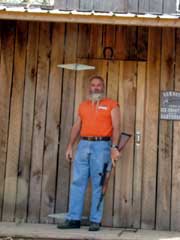
Complete with scope, the Marlin Guide Gun packs
enough power to kill any creature on Earth into a very
handy package.
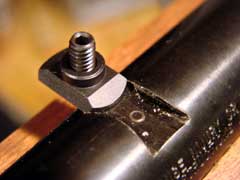
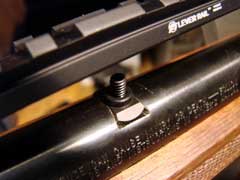
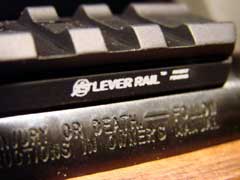
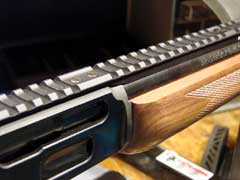
Author installed an XS Lever Rail package, an
ideal solution for mounting a scope on the Marlin.
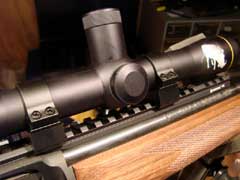


Leupold's quick-detach rings are perfect for
this application.
|
  
Got something to say about this article? Want to agree (or
disagree) with it? Click the following link to go to the GUNBlast Feedback Page.
|
|
Click pictures for a larger version.
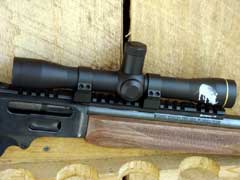
Leupold Custom Shop Scout Scope, mounted on Jeff's
Marlin .45-70 Guide Gun.
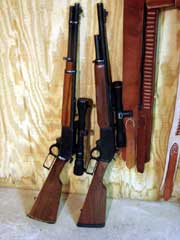
Marlin 1895G is no bigger or heavier than an
18-1/2" barreled .30-30.
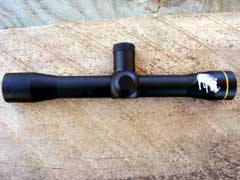
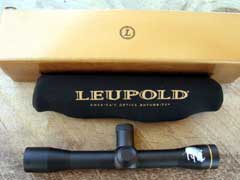

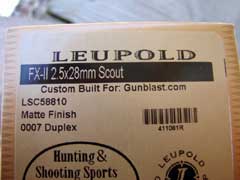
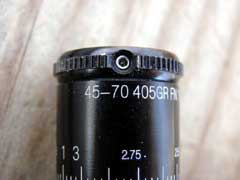

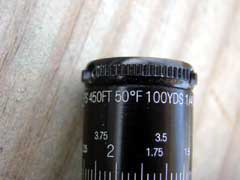
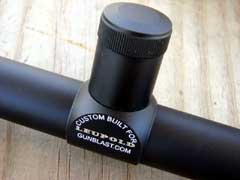
Custom elevation turret is calibrated for a 405-grain
bullet at 1800 feet per second.
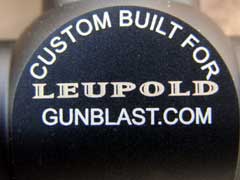
Leupold's Custom Shop allowed the author to indulge in a
bit of vanity at a very reasonable price.

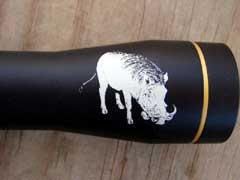
Warthog graphic adds an appropriate touch of
distinction.
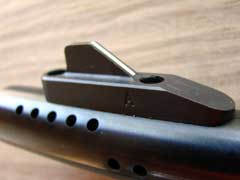

XS front sight & rear iron sights are a
rugged, precise and quickly-available backup.
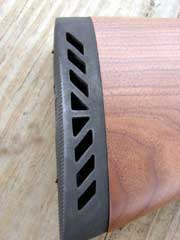

Pachmayr's Decelerator recoil pad, available from
Brownell's, completes the package.
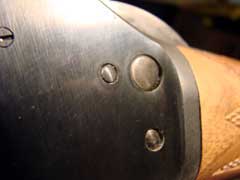
Deactivated crossbolt safety.
|
![]()